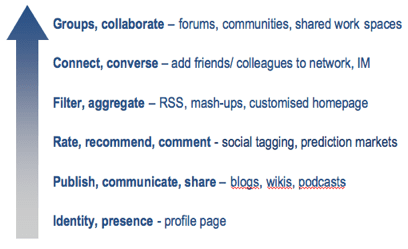Employee directory – the next generation
Back in March I wrote about the potential of the employee directory as a richer, more dynamic tool on the intranet. It’s one topic we’ve been focussing on in the IBF research programme and are just about to publish a (member only) report written by Stephan Schillerwein on the next generation of employee directories – or “wave three” as we’re calling it. While “wave two” already sees the employee directory as a robust “killer application” on the intranet, “wave three” represents a leap forward in features and functionality. In a nutshell…
“The fundamental change in wave three is that the intranet (focused on content) and the directory (focused on people) are growing together. Thus content and people are put into context… people do not come to an intranet for content per se; instead, they are looking for answers to their questions, which can come either from content or from people.”
Many of the features of a “wave three” directory incorporate elements of social networking tools, such as: skills and interests, recent blog posts, favourites, presence information and network of colleagues or friends. But it can also incorporate other functionality such as specific views for managers and HR to manage talent and performance more easily.
The report goes on to look at the two core elements of a “wave three” directory:
“integrate everything: integrate as many relevant systems as possible to provide a full and automatically updated picture of people and all their activities (as compared to people having to manually enter what they are doing or have done)
link everything: connect and transparently link people, content and context in order to display every relation between them. Thus, multiple options and perspectives for every piece of information or person can be provided, serving many different information needs and ‘views of the world’.”
And cites the potential benefits of developing the employee directory in this way:
- faster location of expertise leading to increased productivity
- enhanced collaboration, creating new ideas and value
- improved organisational ability to manage talent and change
- support for a corporate culture that encourages
- collaboration, knowledge sharing, trust and openness
- improved satisfaction and engagement of employees, especially those used to social networking on the web
- reduced email load
- employees can build trusted networks and communities, giving them greater control over the information and communication they are subjected to
- security of information because employees are not driven to use web-based social networking for work purposes.
As well as looking at the benefits, several very interesting case studies, and recommendations for deploying this kind of directory, the report also looks at the challenges that this may involve. One of these challenges is the management of privacy and data, that may vary across different operating countries for a global organization – a challenge that is addressed with a combination of clear policies, making some elements voluntary and a preparedness to follow through on any breach of the policy.
Another challenge is encouraging people to contribute actively to the directory, something that many organisations struggle with even in a “wave two” style directory. Personally, I wonder how this challenge of getting people to update their profile may change though as social networking behind the firewall becomes more accepted and integrated? I recently drew the following diagram, partly inspired by an article I read on ‘Elements of the Social Software Stack’, to show social software tools in context of their use. In this model, the profile page (of the employee directory in a ‘behind the firewall’ scenario) seems to form a foundation for the various interactions and activities via social networking tools and the building of personal credibility through them. It brings together everything that constitutes my “presence” online as an individual.

In the most connected organizations, will efforts to encourage contribution be superceded by the desire to build personal credibility driving a proactive approach to contributing content to the profile page? And given the nature of the “wave three” directory, should we even be calling it an “employee directory” at the next stage? It seems a very formal name for a tool that increasingly integrates less formal content (mind you, so does “intranet” for that matter).
Categorised in: Digital employee experience, Intranets
